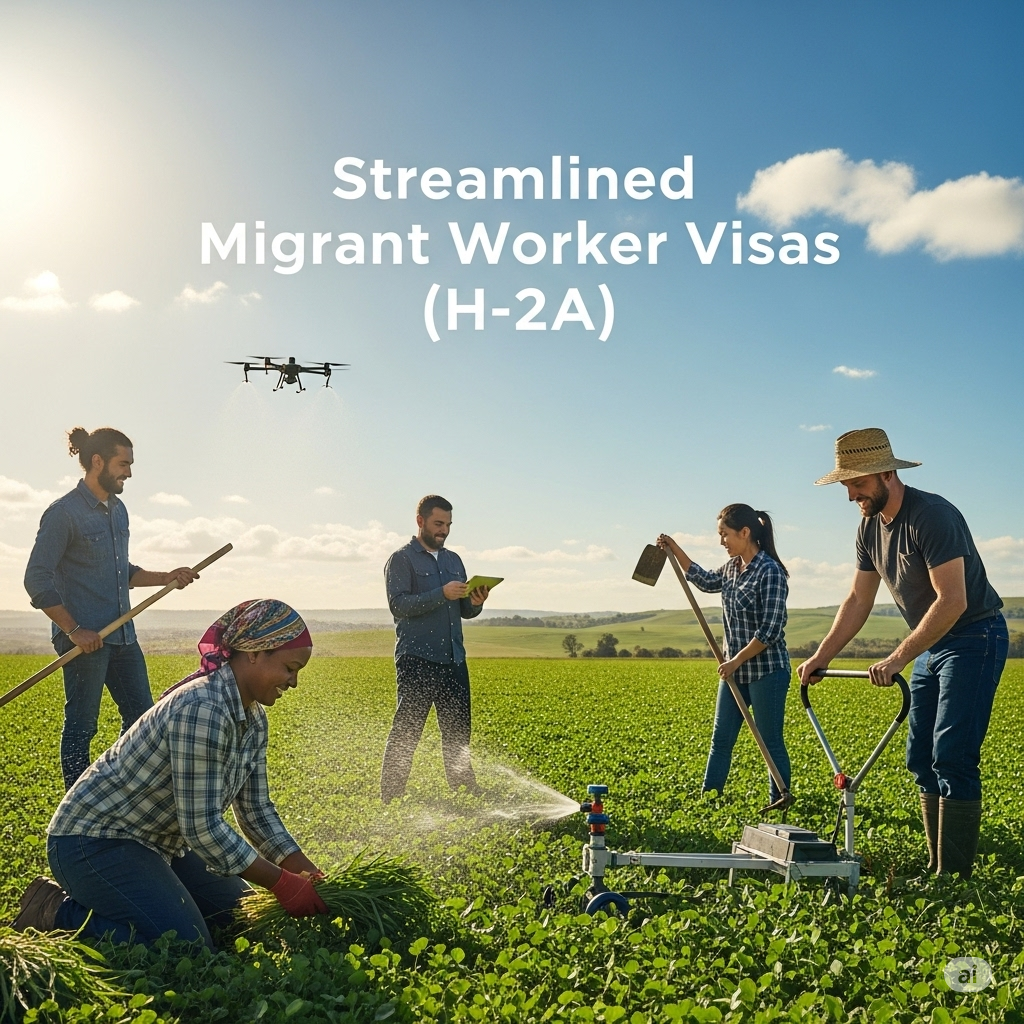The agricultural sector is a cornerstone of the global economy, and in the United States, it relies heavily on a dedicated workforce. However, a persistent shortage of domestic labor has made the H-2A visa program a critical lifeline for American farms.2 This program allows employers to bring temporary agricultural workers from other countries to fill seasonal jobs.3 In recent years, the H-2A program has undergone significant changes aimed at both streamlined migrant worker visas (H-2A) processes and enhanced worker protections.4 This comprehensive guide delves into the nuances of the H-2A visa, outlining the application process, recent regulatory shifts, and the broader implications for both employers and workers.
Table of Contents
The Foundation of the H-2A Program
The H-2A visa program is a non-immigrant visa classification that permits U.S. employers to bring foreign nationals to the United States to perform temporary or seasonal agricultural work.5 This is only permitted after the employer demonstrates that there are not enough qualified, willing, and available U.S. workers to do the job. The program is governed by several U.S. government agencies, including the Department of Labor (DOL), U.S. Citizenship and Immigration Services (USCIS), and the Department of State (DOS).6
The H-2A program is designed to address a real and consistent labor gap in the agricultural industry. In fact, statistics from the U.S. Department of Agriculture show that the number of jobs certified under the H-2A visa program has expanded dramatically over the past decade, with certified jobs increasing more than six-fold between 2005 and 2021.7 This growth underscores the importance of streamlined migrant worker visas (H-2A) for maintaining the integrity of the nation’s food supply.
Key Requirements for Employers
To be eligible for the H-2A visa program, employers must meet a series of strict requirements to ensure that foreign workers are not adversely affecting the wages and working conditions of U.S. workers.8 These requirements include:
- Temporary or Seasonal Need: The work must be for a limited period, generally no longer than one year, and tied to a recurring event or pattern, like a harvest season.9
- Adverse Effect Wage Rate (AEWR): Employers must pay their temporary agricultural workers at least the highest of the federal or state minimum wage, the prevailing wage rate, the collective bargaining wage, or the AEWR for their specific state.10 This wage rate is determined by the DOL to prevent a negative impact on the wages of domestic workers.11 You can find the latest AEWR information on the Department of Labor’s website.
- Recruitment of U.S. Workers: Employers must actively attempt to recruit U.S. workers for the positions before turning to the H-2A visa program.12 This includes placing job orders with the state workforce agency and often reaching out to former U.S. employees.13 They must also continue to hire qualified U.S. workers for the first 50% of the contract period.14
- Provision of Housing and Transportation: Employers must provide free housing that meets specific safety and health standards for workers who cannot return to their homes on the same day.15 They must also cover the cost of daily transportation to and from the worksite, and provide weekly transportation to a grocery store.
- Guarantee of Work Hours: Employers are required to guarantee each H-2A worker employment hours equal to at least 75% of the total workdays specified in the contract. This “three-fourths guarantee” protects workers from being brought to the U.S. only to have their hours cut unexpectedly.
Recent Changes and Regulatory Updates
The H-2A program changes have been a focal point of recent regulatory action.16 In an effort to enhance worker protections and increase transparency, the Department of Labor has introduced new rules.17 These changes are designed to safeguard vulnerable workers and hold employers more accountable.18
One significant change, for example, strengthens protections against retaliation and clarifies the conditions under which a worker can be terminated.19 The new regulations aim to prevent employers from arbitrarily firing H-2A workers for raising concerns or exercising their rights.20 This is a key step towards improving the conditions for temporary agricultural workers who may feel trapped or unable to speak out against unfair labor practices.
Another important update requires mandatory public disclosure of the names and contact information of any person or entity involved in recruiting foreign workers.21 This aims to bring more transparency to the recruitment process and help prevent fraudulent practices. The H-2A program changes also include a clearer definition of “egregious misconduct” for termination, which requires the use of a system of progressive discipline in most cases.22
These regulatory reforms are part of a broader push to modernize the H-2A program and are a direct response to concerns about U.S. farm labor exploitation.23 While these changes are intended to benefit workers, they have also faced legal challenges from some agricultural groups who argue the new rules place an undue burden on employers.24 These legal battles highlight the ongoing tension between protecting workers and ensuring the program remains a viable option for farmers.25
The Application and Visa Process
The process for obtaining streamlined migrant worker visas (H-2A) involves several steps for both the employer and the prospective worker.26
Employer’s Role
The employer begins the process by filing a job order with the appropriate State Workforce Agency (SWA) and then submitting an H-2A Application for Temporary Employment Certification (Form ETA-9142A) to the Department of Labor’s Office of Foreign Labor Certification (OFLC) .27 This application must be filed no less than 45 days before the work start date. Once the DOL grants a temporary labor certification, the employer must file a Form I-129, Petition for a Nonimmigrant Worker, with USCIS.28 If the petition is approved, the employer will then receive a notice of approval that is used by the worker to apply for their visa.29
Worker’s Role
Prospective H-2A workers who are outside the U.S. must then apply for an H-2A visa at a U.S. Embassy or Consulate.30 This involves completing an online nonimmigrant visa application (Form DS-160) and attending a visa interview.31 During the interview, consular officers will verify the worker’s eligibility and determine if they meet the requirements of U.S. law.32 It is crucial for workers to have all the necessary documents, including a valid passport, their DS-160 confirmation page, and the petition receipt number.
FAQ Section
Q1: Who is eligible for an H-2A visa?
A: To be eligible, you must be a citizen of a country designated by the Secretary of Homeland Security as being eligible to participate in the H-2A visa program. You must also have a job offer from a U.S. employer for temporary or seasonal agricultural work.
Q2: How long can an H-2A visa holder stay in the U.S.?
A: An H-2A worker can be granted a stay for up to the period authorized on the temporary labor certification, generally up to one year.33 The visa can be extended for qualifying employment in one-year increments for a maximum total stay of three years.34 After three years, a worker must depart the U.S. and remain outside for at least 60 uninterrupted days before becoming re-eligible.35
Q3: Can my family join me on an H-2A visa?
A: The spouse and unmarried children under 21 years of age of an H-2A worker may be eligible to seek admission to the U.S. in the H-4 dependent nonimmigrant classification.36 However, H-4 visa holders are generally not authorized to work in the U.S.
Disclaimer
This article is for informational purposes only and does not constitute legal advice. The H-2A visa program is complex and subject to change. Readers should consult with an immigration attorney or a qualified legal professional for advice on their specific situation. For the most accurate and up-to-date information, please refer to the official websites of the U.S. government agencies responsible for the program, including the U.S. Department of Labor and U.S. Citizenship and Immigration Services.
Affiliate Disclosure
This article may contain links to products or services from which we may receive a commission. This disclosure is made in accordance with the Federal Trade Commission’s 16 CFR, Part 255.
Related Topics
For further reading on U.S. farm labor and immigration, consider exploring these topics:
- H-2B Visa Program: This program is for temporary non-agricultural workers and operates with a similar, but distinct, framework.37
- The Farm Workforce Modernization Act: A legislative proposal that has been a significant topic of discussion regarding immigration reform and its potential impact on temporary agricultural workers.
- Agricultural Labor Shortages: Articles and reports detailing the economic impact of labor shortages on the U.S. farm labor market and food production.







